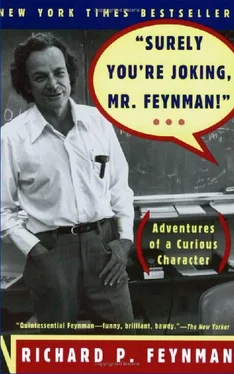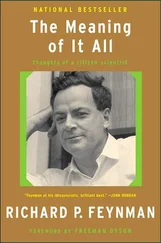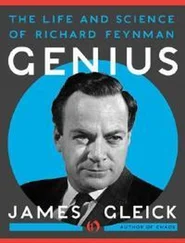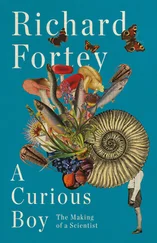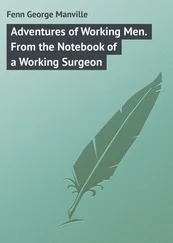“Well,” he said, “if you mix red and white, you’ll get yellow.”
“Are you sure you don’t mean pink? ”
“No,” he said, “you’ll get yellow”—and I believed that he got yellow, because he was a professional painter, and I always admired guys like that. But I still wondered how he did it.
I got an idea. “It must be some kind of chemical change. Were you using some special kind of pigments that make a chemical change?”
“No,” he said, “any old pigments will work. You go down to the five-and-ten and get some paint—just a regular can of red paint and a regular can of white paint—and I’ll mix ’em, and I’ll show how you get yellow.”
At this juncture I was thinking, “Something is crazy. I know enough about paints to know you won’t get yellow, but he must know that you do get yellow, and therefore something interesting happens. I’ve got to see what it is!”
So I said, “OK, I’ll get the paints.”
The painter went back upstairs to finish his painting job, and the restaurant owner came over and said to me, “What’s the idea of arguing with that man? The man is a painter; he’s been a painter all his life, and he says he gets yellow. So why argue with him?”
I felt embarrassed. I didn’t know what to say. Finally I said, “All my life, I’ve been studying light. And I think that with red and white you can’t get yellow—you can only get pink.”
So I went to the five-and-ten and got the paint, and brought it back to the restaurant. The painter came down from upstairs, and the restaurant owner was there too. I put the cans of paint on an old chair, and the painter began to mix the paint. He put a little more red, he put a little more white—it still looked pink to me—and he mixed some more. Then he mumbled something like, “I used to have a little tube of yellow here to sharpen it up a bit—then this’ll be yellow.”
“Oh!” I said. “Of course! You add yellow, and you can get yellow, but you couldn’t do it without the yellow.”
The painter went back upstairs to paint.
The restaurant owner said, “That guy has his nerve, arguing with a guy who’s studied light all his life!”
But that shows you how much I trusted these “real guys.” The painter had told me so much stuff that was reasonable that I was ready to give a certain chance that there was an odd phenomenon I didn’t know. I was expecting pink, but my set of thoughts were, “The only way to get yellow will be something new and interesting, and I’ve got to see this.”
I’ve very often made mistakes in my physics by thinking the theory isn’t as good as it really is, thinking that there are lots of complications that are going to spoil it—an attitude that anything can happen, in spite of what you’re pretty sure should happen.
At the Princeton graduate school, the physics department and the math department shared a common lounge, and every day at four o’clock we would have tea. It was a way of relaxing in the afternoon, in addition to imitating an English college. People would sit around playing Go, or discussing theorems. In those days topology was the big thing.
I still remember a guy sitting on the couch, thinking very hard, and another guy standing in front of him, saying, “And therefore such-and-such is true.”
“Why is that?” the guy on the couch asks.
“It’s trivial! It’s trivial!” the standing guy says, and he rapidly reels off a series of logical steps: “First you assume thus-and-so, then we have Kerchoff’s this-and-that; then there’s Waffenstoffer’s Theorem, and we substitute this and construct that. Now you put the vector which goes around here and then thus-and-so …” The guy on the couch is struggling to understand all this stuff, which goes on at high speed for about fifteen minutes!
Finally the standing guy comes out the other end, and the guy on the couch says, “Yeah, yeah. It’s trivial.”
We physicists were laughing, trying to figure them out. We decided that “trivial” means “proved.” So we joked with the mathematicians: “We have a new theorem—that mathematicians can prove only trivial theorems, because every theorem that’s proved is trivial.”
The mathematicians didn’t like that theorem, and I teased them about it. I said there are never any surprises—that the mathematicians only prove things that are obvious.
Topology was not at all obvious to the mathematicians. There were all kinds of weird possibilities that were “counterintuitive.” Then I got an idea. I challenged them: “I bet there isn’t a single theorem that you can tell me—what the assumptions are and what the theorem is in terms I can understand—where I can’t tell you right away whether it’s true or false.”
It often went like this: They would explain to me, “You’ve got an orange, OK? Now you cut the orange into a finite number of pieces, put it back together, and it’s as big as the sun. True or false?”
“No holes?”
“No holes.”
“Impossible! There ain’t no such a thing.”
“Ha! We got him! Everybody gather around! It’s So-and-so’s theorem of immeasurable measure!”
Just when they think they’ve got me, I remind them, “But you said an orange! You can’t cut the orange peel any thinner than the atoms.”
“But we have the condition of continuity: We can keep on cutting!”
“No, you said an orange, so I assumed that you meant a real orange .”
So I always won. If I guessed it right, great. If I guessed it wrong, there was always something I could find in their simplification that they left out.
Actually, there was a certain amount of genuine quality to my guesses. I had a scheme, which I still use today when somebody is explaining something that I’m trying to understand: I keep making up examples. For instance, the mathematicians would come in with a terrific theorem, and they’re all excited. As they’re telling me the conditions of the theorem, I construct something which fits all the conditions. You know, you have a set (one ball)—disjoint (two balls). Then the balls turn colors, grow hairs, or whatever, in my head as they put more conditions on. Finally they state the theorem, which is some dumb thing about the ball which isn’t true for my hairy green ball thing, so I say, “False!”
If it’s true, they get all excited, and I let them go on for a while. Then I point out my counterexample.
“Oh. We forgot to tell you that it’s Class 2 Hausdorff homomorphic.”
“Well, then,” I say, “It’s trivial! It’s trivial!” By that time I know which way it goes, even though I don’t know what Hausdorff homomorphic means.
I guessed right most of the time because although the mathematicians thought their topology theorems were counterintuitive, they weren’t really as difficult as they looked. You can get used to the funny properties of this ultra-fine cutting business and do a pretty good job of guessing how it will come out.
Although I gave the mathematicians a lot of trouble, they were always very kind to me. They were a happy hunch of boys who were developing things, and they were terrifically excited about it. They would discuss their “trivial” theorems, and always try to explain something to you if you asked a simple question.
Paul Olum and I shared a bathroom. We got to be good friends, and he tried to teach me mathematics. He got me up to homotopy groups, and at that point I gave up. But the things below that I understood fairly well.
One thing I never did learn was contour integration. I had learned to do integrals by various methods shown in a book that my high school physics teacher Mr. Bader had given me.
Читать дальше
